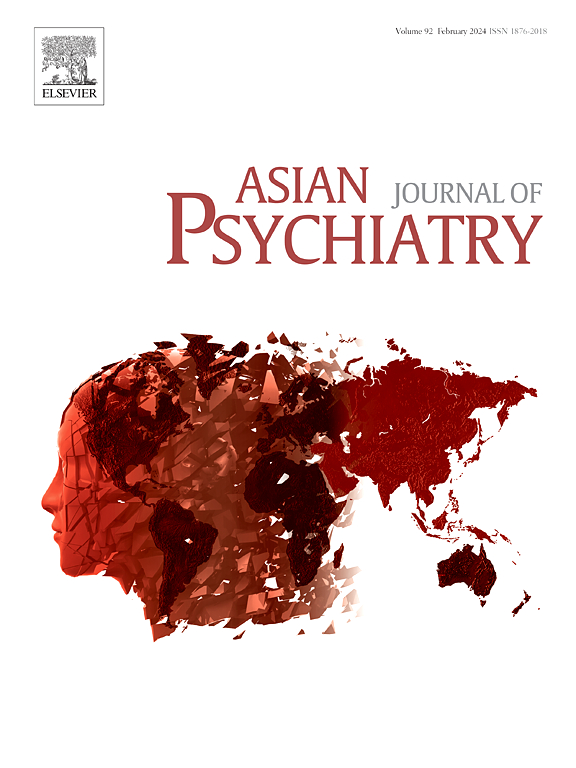Human-fecal microbiota transplantation in relation to gut microbiome signatures in animal models for schizophrenia: A scoping review
IF 3.8
4区 医学
Q1 PSYCHIATRY
引用次数: 0
Abstract
More recently, attention has turned to the putative role of gut microbiome (GMB) in pathogenesis, symptomatology, treatment response and/or resistance in schizophrenia (SCZ). It is foreseeable that fecal microbiota transplantation (FMT) from SCZ patients (SCZ-FMT) to germ-free mice could represent a suitable experimental framework for a better understanding of the relationship between GMB and SCZ. Thus, we set out to identify literature (i) characterizing the GMB in animal models of SCZ, and (ii) employing SCZ-FMT into rodents to model SCZ in relation to behavioral and molecular phenotypes. Five studies examining animal models of SCZ suggest distinct GMB composition compared to respective control groups, which was correlated with SCZ-like behavioral phenotypes. Four additional studies investigated SCZ-FMT into rodents in relation to behavioral phenotypes, including spontaneous hyperlocomotion, social deficits, exaggerated startle response, and cognitive impairments, resembling those observed in SCZ patients. Mice receiving SCZ-FMT showed altered neurochemical and metabolic pathways in the brain. Animal models of SCZ have shown altered GMB composition, whereas reported behavioral and neurochemical alterations following FMT from patients into rodents suggest early face and construct validity for SCZ-FMT animal models. However, the predictive validity of these models remains to be validated.
人类粪便微生物群移植与精神分裂症动物模型中肠道微生物群特征的关系:范围综述
最近,人们开始关注肠道微生物组(GMB)在精神分裂症(SCZ)的发病机制、症状、治疗反应和/或抗药性中的作用。可以预见,将精神分裂症(SCZ)患者的粪便微生物群(FMT)移植到无菌小鼠体内,是更好地了解肠道微生物群与精神分裂症(SCZ)之间关系的合适实验框架。因此,我们开始寻找以下文献:(i) 描述 SCZ 动物模型中 GMB 特征的文献;(ii) 将 SCZ-FMT 移植到啮齿类动物体内以建立 SCZ 行为和分子表型模型的文献。五项关于 SCZ 动物模型的研究表明,与各自的对照组相比,GMB 的组成与 SCZ 类行为表型相关。另有四项研究调查了啮齿类动物的SCZ-FMT与行为表型的关系,包括自发性运动过度、社交障碍、夸张的惊吓反应和认知障碍,这些都与在SCZ患者身上观察到的表型相似。接受SCZ-FMT治疗的小鼠表现出大脑神经化学和代谢途径的改变。SCZ动物模型显示了GMB组成的改变,而据报道,从患者到啮齿类动物的FMT后的行为和神经化学改变表明了SCZ-FMT动物模型的早期面貌和构造的有效性。然而,这些模型的预测有效性仍有待验证。
本文章由计算机程序翻译,如有差异,请以英文原文为准。
求助全文
约1分钟内获得全文
求助全文
来源期刊

Asian journal of psychiatry
Medicine-Psychiatry and Mental Health
CiteScore
12.70
自引率
5.30%
发文量
297
审稿时长
35 days
期刊介绍:
The Asian Journal of Psychiatry serves as a comprehensive resource for psychiatrists, mental health clinicians, neurologists, physicians, mental health students, and policymakers. Its goal is to facilitate the exchange of research findings and clinical practices between Asia and the global community. The journal focuses on psychiatric research relevant to Asia, covering preclinical, clinical, service system, and policy development topics. It also highlights the socio-cultural diversity of the region in relation to mental health.
 求助内容:
求助内容: 应助结果提醒方式:
应助结果提醒方式:


